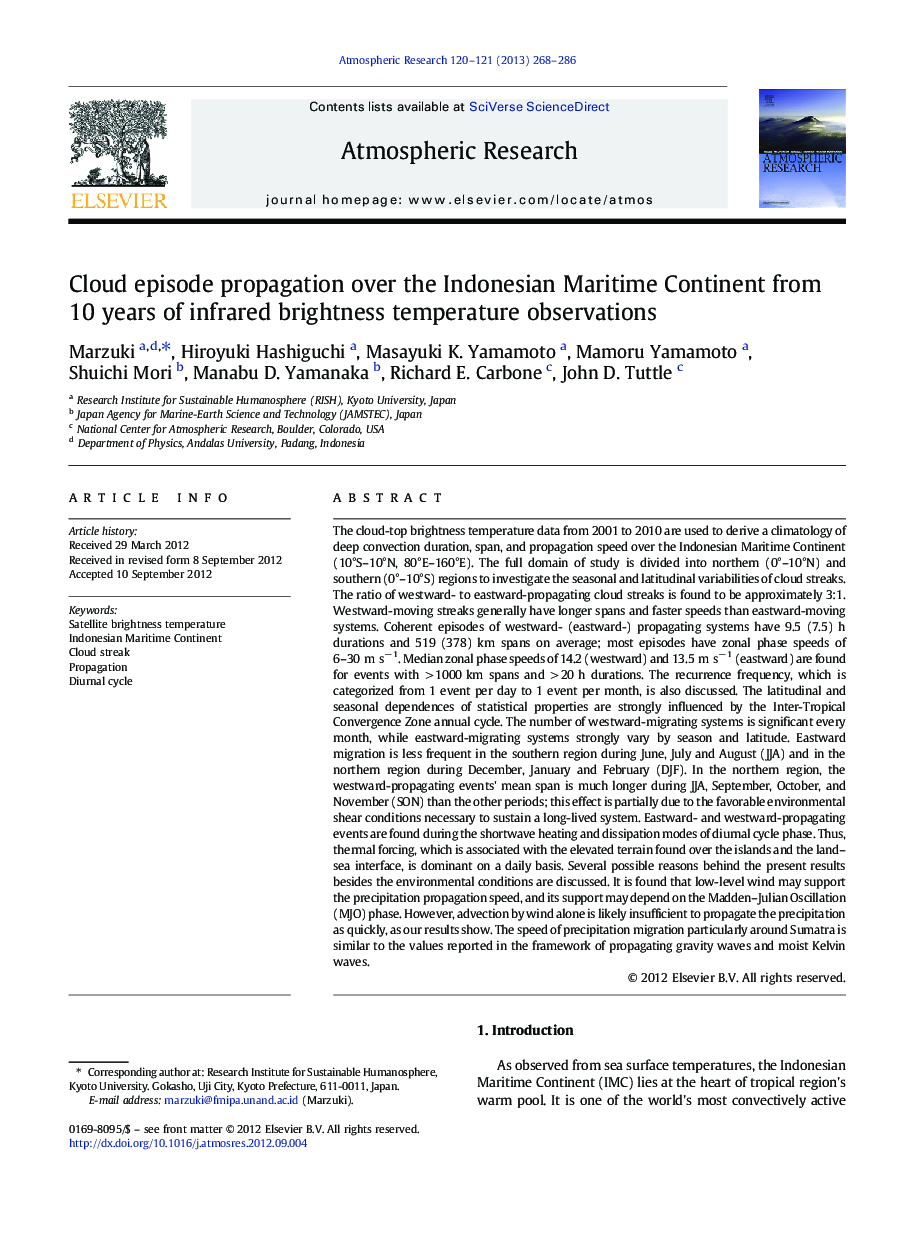| کد مقاله | کد نشریه | سال انتشار | مقاله انگلیسی | نسخه تمام متن |
|---|---|---|---|---|
| 4450141 | 1620545 | 2013 | 19 صفحه PDF | دانلود رایگان |

The cloud-top brightness temperature data from 2001 to 2010 are used to derive a climatology of deep convection duration, span, and propagation speed over the Indonesian Maritime Continent (10°S–10°N, 80°E–160°E). The full domain of study is divided into northern (0°–10°N) and southern (0°–10°S) regions to investigate the seasonal and latitudinal variabilities of cloud streaks. The ratio of westward- to eastward-propagating cloud streaks is found to be approximately 3:1. Westward-moving streaks generally have longer spans and faster speeds than eastward-moving systems. Coherent episodes of westward- (eastward-) propagating systems have 9.5 (7.5) h durations and 519 (378) km spans on average; most episodes have zonal phase speeds of 6–30 m s− 1. Median zonal phase speeds of 14.2 (westward) and 13.5 m s− 1 (eastward) are found for events with > 1000 km spans and > 20 h durations. The recurrence frequency, which is categorized from 1 event per day to 1 event per month, is also discussed. The latitudinal and seasonal dependences of statistical properties are strongly influenced by the Inter-Tropical Convergence Zone annual cycle. The number of westward-migrating systems is significant every month, while eastward-migrating systems strongly vary by season and latitude. Eastward migration is less frequent in the southern region during June, July and August (JJA) and in the northern region during December, January and February (DJF). In the northern region, the westward-propagating events' mean span is much longer during JJA, September, October, and November (SON) than the other periods; this effect is partially due to the favorable environmental shear conditions necessary to sustain a long-lived system. Eastward- and westward-propagating events are found during the shortwave heating and dissipation modes of diurnal cycle phase. Thus, thermal forcing, which is associated with the elevated terrain found over the islands and the land–sea interface, is dominant on a daily basis. Several possible reasons behind the present results besides the environmental conditions are discussed. It is found that low-level wind may support the precipitation propagation speed, and its support may depend on the Madden–Julian Oscillation (MJO) phase. However, advection by wind alone is likely insufficient to propagate the precipitation as quickly, as our results show. The speed of precipitation migration particularly around Sumatra is similar to the values reported in the framework of propagating gravity waves and moist Kelvin waves.
► Ratio of westward to eastward propagating systems was approximately 3:1.
► Westward-moving streaks generally have longer spans and faster speeds.
► Mean duration and span of westward- (eastward-) are 9.5 (7.5) h and 519 (378) km.
► Span, duration and propagation speed are smaller than in midlatitudes.
► The latitudinal and seasonal variations are strongly influenced by the ITCZ cycle.
Journal: Atmospheric Research - Volumes 120–121, February 2013, Pages 268–286